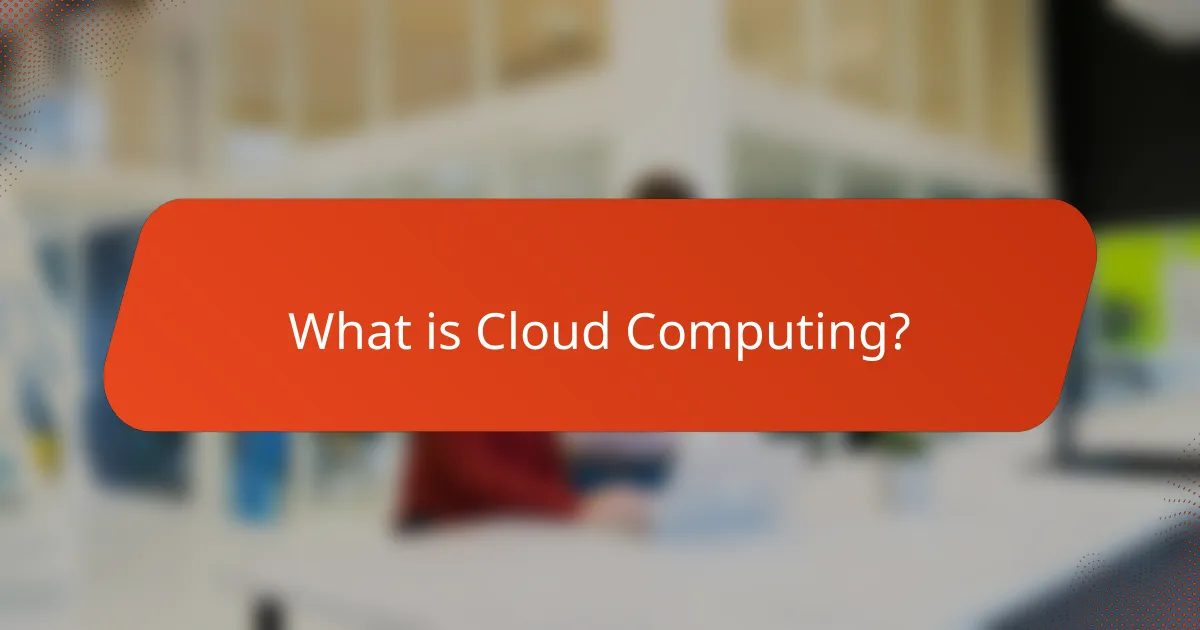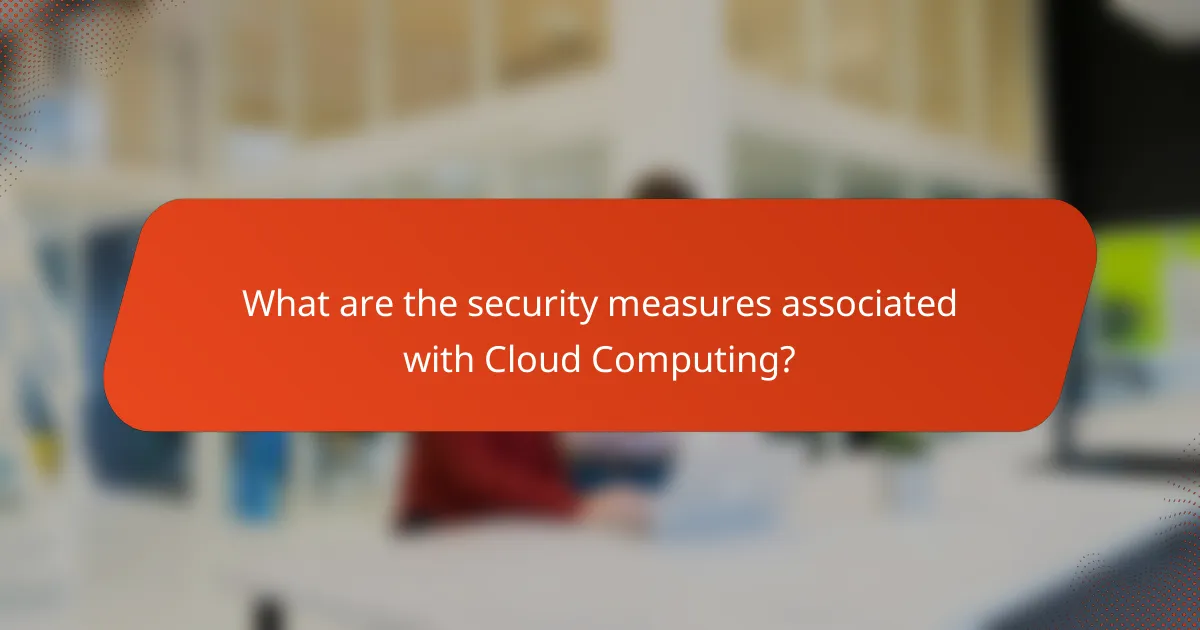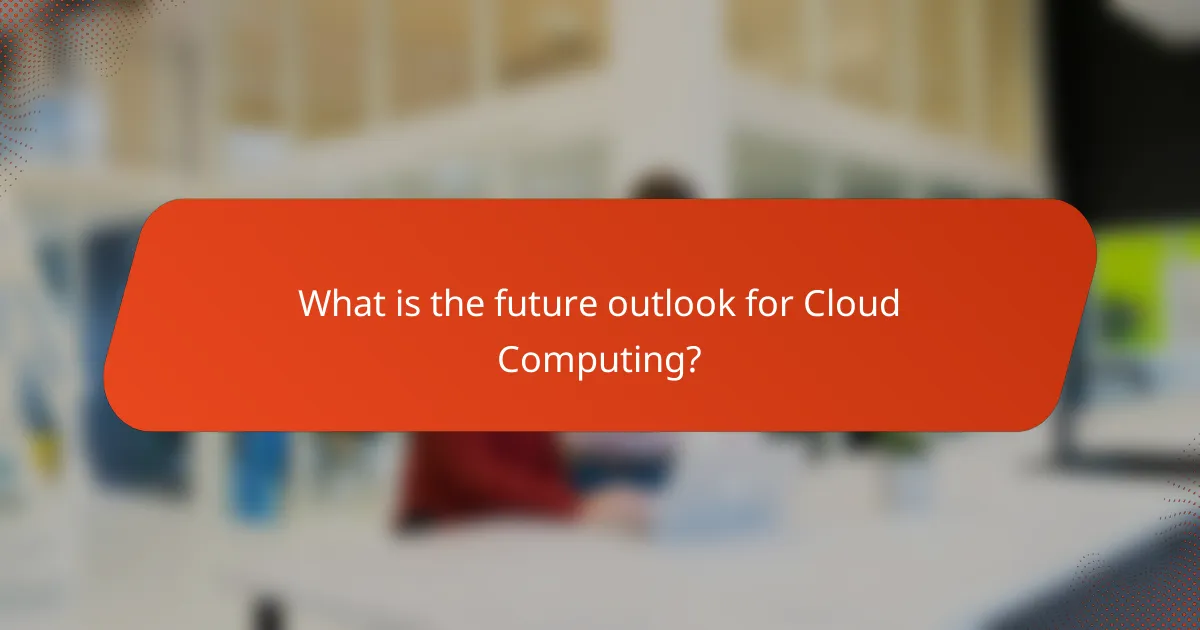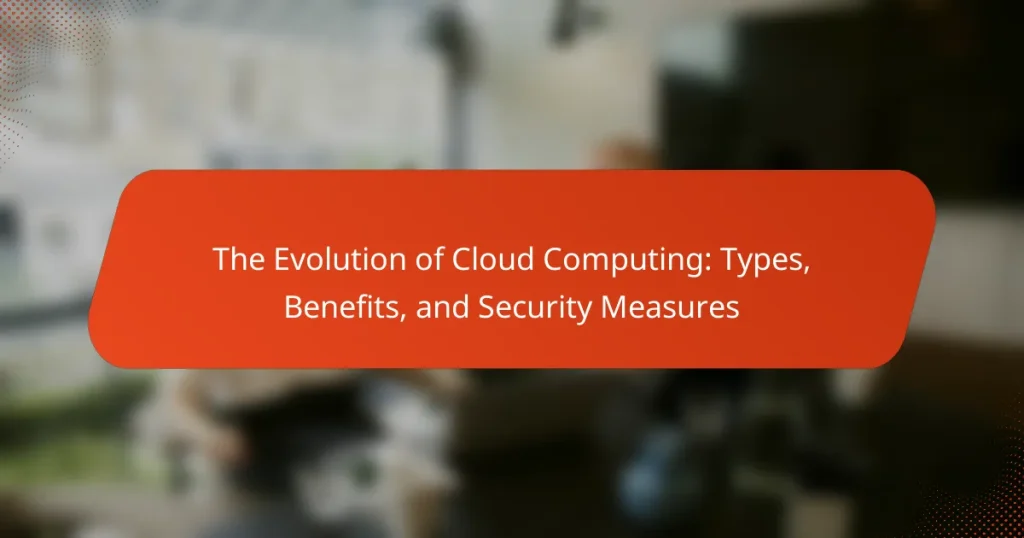Cloud computing refers to the delivery of computing services, including storage, processing power, and applications, over the internet. This technology allows users to access resources on demand without the need for physical hardware, providing businesses with scalability and flexibility. The article explores the growth of the cloud computing market, projected to reach $1.6 trillion by 2027, and the key security measures that protect cloud environments, such as data encryption and access control. Additionally, it discusses the increasing adoption of hybrid and multi-cloud strategies, the impact of AI and machine learning on cloud operations, and the ongoing evolution of cloud computing in driving digital transformation across various industries.

What is Cloud Computing?
Cloud computing is the delivery of computing services over the internet. These services include storage, processing power, and applications. Users can access these resources on demand, without needing physical hardware. Cloud computing enables scalability and flexibility for businesses. According to a 2020 report by Gartner, the global cloud services market was projected to reach $266.4 billion. This growth reflects the increasing reliance on cloud solutions for efficiency and cost-effectiveness. Cloud computing allows users to pay only for what they use, optimizing expenses. Major providers include Amazon Web Services, Microsoft Azure, and Google Cloud.
How has Cloud Computing evolved over the years?
Cloud computing has evolved significantly since its inception. Initially, cloud computing began in the 1960s with mainframe computing, allowing multiple users to access a single powerful computer. In the late 1990s, the term “cloud computing” emerged, popularized by companies like Salesforce, which offered software as a service (SaaS). The early 2000s saw the rise of infrastructure as a service (IaaS) and platform as a service (PaaS) models, with Amazon Web Services launching in 2006. By the 2010s, cloud computing became mainstream, with businesses adopting hybrid and multi-cloud strategies. Today, cloud computing supports advanced technologies like artificial intelligence and machine learning. The global cloud market is projected to reach $832.1 billion by 2025, indicating its pervasive growth and importance in modern IT infrastructure.
What key milestones mark the evolution of Cloud Computing?
The evolution of cloud computing is marked by several key milestones. In the 1960s, the concept of time-sharing emerged, allowing multiple users to share computing resources. In the 1990s, the term “cloud computing” was popularized with the advent of the internet. In 2002, Amazon Web Services launched, providing scalable cloud storage and computing. In 2006, Google introduced its cloud platform, further expanding the market. The introduction of Infrastructure as a Service (IaaS) and Software as a Service (SaaS) models in the late 2000s revolutionized access to technology. By 2010, cloud computing became mainstream, with businesses increasingly adopting it for efficiency and cost savings. Today, cloud computing continues to evolve with advancements in artificial intelligence and machine learning integration. These milestones demonstrate the rapid development and widespread adoption of cloud computing technologies.
How have technological advancements influenced Cloud Computing?
Technological advancements have significantly influenced cloud computing by enhancing its scalability, efficiency, and accessibility. Innovations in virtualization technology allow multiple operating systems to run on a single physical server. This improves resource utilization and reduces costs. Furthermore, advancements in networking, such as 5G, enable faster data transfer and lower latency. This enhances the user experience for cloud-based applications. Additionally, improvements in data storage technologies, like SSDs, increase data retrieval speeds. This supports the growing demand for cloud services. Security enhancements, including advanced encryption methods, have made cloud computing safer for businesses. These technological developments have collectively transformed cloud computing into a vital component of modern IT infrastructure.
What are the different types of Cloud Computing?
The different types of cloud computing are Infrastructure as a Service (IaaS), Platform as a Service (PaaS), and Software as a Service (SaaS). IaaS provides virtualized computing resources over the internet. Users can rent servers, storage, and networking on a pay-as-you-go basis. PaaS offers a platform allowing developers to build, deploy, and manage applications without dealing with infrastructure. It streamlines the development process by providing tools and services. SaaS delivers software applications over the internet on a subscription basis. Users access software via web browsers without needing installation. These models represent distinct layers of cloud services, catering to different business needs.
What distinguishes Public Cloud from Private Cloud?
Public Cloud is a cloud computing model where services are delivered over the internet to multiple users. Private Cloud, on the other hand, is a cloud environment dedicated to a single organization. Public Cloud offers scalability and cost-effectiveness due to shared resources. Private Cloud provides enhanced security and control since it is not shared with other organizations. Public Cloud services are typically managed by third-party providers. Private Cloud is often managed internally or by a single vendor. Public Cloud is suitable for businesses with variable workloads. Private Cloud is ideal for organizations with strict compliance and data privacy requirements.
How does Hybrid Cloud combine elements of both Public and Private Clouds?
Hybrid Cloud integrates both Public and Private Clouds by allowing data and applications to be shared between them. This model provides the scalability and cost-effectiveness of Public Clouds. At the same time, it offers the control and security of Private Clouds. Organizations can store sensitive data in the Private Cloud while leveraging the Public Cloud for less critical resources. This combination enables businesses to adapt to changing workloads efficiently. According to a 2022 report by Gartner, 70% of organizations will adopt a Hybrid Cloud model by 2025, highlighting its growing importance.
What is the role of Community Cloud in Cloud Computing?
Community Cloud serves a shared infrastructure for multiple organizations with common interests. It enables collaboration and resource sharing among entities within a specific community. This cloud model is tailored to meet the needs and requirements of a particular group. Organizations benefit from reduced costs and increased efficiency. Security and compliance are enhanced due to shared governance. Community Cloud can be deployed on-premises or through a third-party provider. This flexibility supports various operational models. According to a study by Gartner, organizations leveraging Community Cloud can achieve significant cost savings compared to private cloud solutions.
What benefits does Cloud Computing provide to businesses?
Cloud computing provides businesses with cost savings, scalability, and enhanced collaboration. It reduces IT expenses by eliminating the need for physical infrastructure. According to a study by Gartner, businesses can save up to 30% on IT costs by adopting cloud solutions. Scalability allows organizations to adjust resources based on demand, ensuring efficiency during peak times. Enhanced collaboration is achieved through real-time access to data and applications from any location. This flexibility supports remote work and improves productivity. Cloud computing also offers robust security measures, with data encryption and compliance certifications. As a result, businesses can focus on innovation and growth while minimizing operational risks.
How does Cloud Computing enhance scalability for organizations?
Cloud computing enhances scalability for organizations by providing on-demand resources. This allows businesses to quickly adjust their computing power based on current needs. Organizations can scale up during peak times and scale down during off-peak times. This flexibility reduces the need for physical hardware investments. Cloud providers offer various services that can be accessed as needed. For example, companies can increase storage or processing power without significant delays. Studies indicate that organizations using cloud solutions can improve their operational efficiency by up to 30%. This capability supports growth and innovation while minimizing costs.
What cost savings can businesses expect from adopting Cloud Computing?
Businesses can expect significant cost savings from adopting Cloud Computing. These savings typically stem from reduced IT infrastructure costs. Companies can eliminate the need for expensive hardware purchases. Additionally, maintenance and upgrade costs are significantly lowered. Cloud services often operate on a pay-as-you-go model. This allows businesses to pay only for what they use. Research indicates that organizations can save up to 30% on IT costs by migrating to the cloud. Furthermore, operational efficiency is enhanced, leading to increased productivity and reduced labor costs. Overall, Cloud Computing provides a financially viable solution for modern businesses.
How does Cloud Computing improve collaboration among teams?
Cloud computing improves collaboration among teams by providing real-time access to shared resources and data. It allows team members to work together from different locations seamlessly. Cloud platforms enable document sharing, editing, and communication in a centralized space. This eliminates version control issues commonly found in traditional file sharing. Tools like Google Workspace and Microsoft 365 exemplify this capability. These platforms support simultaneous editing and instant feedback. According to a report by McKinsey, teams using cloud-based collaboration tools can increase productivity by 20-30%. This demonstrates the significant impact of cloud computing on team collaboration.

What are the security measures associated with Cloud Computing?
Security measures associated with Cloud Computing include data encryption, access control, and regular security audits. Data encryption protects sensitive information by converting it into an unreadable format. Access control ensures that only authorized users can access specific data and services. Regular security audits help identify vulnerabilities and ensure compliance with security standards. Multi-factor authentication adds an extra layer of security by requiring multiple forms of verification. Firewalls protect cloud infrastructure from unauthorized access and cyber threats. Backup and disaster recovery solutions are essential for data integrity and availability. These measures collectively enhance the overall security posture of cloud environments.
How can organizations ensure data security in the Cloud?
Organizations can ensure data security in the Cloud by implementing strong encryption methods. Encryption protects data at rest and in transit, making it unreadable without the appropriate decryption key. Additionally, organizations should use multi-factor authentication to verify user identities. This adds an extra layer of security beyond just passwords. Regular security audits are essential to identify and mitigate vulnerabilities. Monitoring access logs helps detect unauthorized access attempts. Organizations must also ensure compliance with data protection regulations such as GDPR or HIPAA. Using reputable cloud service providers with strong security protocols is crucial. These measures collectively enhance the overall security posture of cloud data.
What encryption methods are commonly used in Cloud security?
Common encryption methods used in cloud security include Advanced Encryption Standard (AES), RSA, and Transport Layer Security (TLS). AES is widely adopted due to its efficiency and strong security, using key sizes of 128, 192, or 256 bits. RSA is commonly used for secure data transmission, particularly for encrypting sensitive information. TLS provides a secure channel over the internet, ensuring data integrity and confidentiality during transmission. These methods are critical for protecting data stored in the cloud and during transfer between users and cloud services. Their effectiveness is supported by industry standards and practices, making them essential in cloud security protocols.
How do access controls protect sensitive information in the Cloud?
Access controls protect sensitive information in the Cloud by regulating who can access data and resources. They ensure that only authorized users can view or modify sensitive information. This is achieved through authentication, which verifies user identities, and authorization, which determines user permissions. Multi-factor authentication adds an extra layer of security by requiring additional verification methods. Role-based access control (RBAC) limits access based on user roles within an organization. Auditing and monitoring track access attempts, providing insights into potential security breaches. According to the Cloud Security Alliance, implementing strong access controls significantly reduces the risk of data breaches.
What are the potential risks and challenges of Cloud Computing?
Cloud computing presents several potential risks and challenges. Data security is a significant concern due to breaches and unauthorized access. Compliance with regulations can be complex, especially in industries with strict data governance. Dependence on internet connectivity poses risks; outages can disrupt access to services. Vendor lock-in can limit flexibility and increase costs over time. Performance issues may arise from shared resources, leading to inconsistent service quality. Additionally, inadequate backup solutions can result in data loss. These challenges highlight the need for robust security measures and careful provider selection.
How can data breaches occur in Cloud environments?
Data breaches can occur in cloud environments due to various vulnerabilities. Misconfigured cloud settings allow unauthorized access to sensitive data. Inadequate access controls can lead to data exposure. Weak authentication methods increase the risk of breaches. Insider threats from employees can compromise data integrity. Malicious attacks such as phishing can target cloud users. Data transfer over unsecured networks can result in interception. According to the 2021 Verizon Data Breach Investigations Report, 22% of data breaches involved cloud-based assets.
What measures can be taken to mitigate Cloud Computing risks?
Implementing strong security protocols is essential to mitigate Cloud Computing risks. Organizations should employ encryption for data both at rest and in transit. Regular security audits help identify vulnerabilities. Multi-factor authentication adds an extra layer of protection for user access. Additionally, adopting a robust incident response plan can effectively address potential breaches. Training employees on best security practices reduces human error. Finally, selecting reputable cloud service providers with strong compliance records further enhances security measures. These steps collectively create a comprehensive strategy to minimize risks associated with Cloud Computing.

What is the future outlook for Cloud Computing?
The future outlook for cloud computing is highly promising. The global cloud computing market is projected to reach $1.6 trillion by 2027, growing at a CAGR of 22.5% from 2020. Businesses increasingly adopt cloud solutions for flexibility and cost efficiency. Hybrid and multi-cloud strategies are becoming more prevalent among enterprises. Security advancements are expected to enhance trust in cloud services. Innovations in AI and machine learning will further optimize cloud operations. The shift towards remote work accelerates demand for cloud infrastructure. Overall, cloud computing will continue to evolve, driving digital transformation across industries.
How will emerging technologies impact Cloud Computing?
Emerging technologies will significantly enhance cloud computing capabilities. They will improve efficiency, scalability, and security. Technologies such as artificial intelligence (AI) and machine learning (ML) will automate resource management. This will optimize performance and reduce operational costs. Additionally, edge computing will enable faster data processing by bringing computation closer to the data source. This will enhance real-time analytics and reduce latency. Blockchain technology will improve data security and integrity in cloud environments. It will enable secure transactions and data sharing. According to a report by Gartner, by 2025, 85% of organizations will leverage cloud services to enhance their digital transformation efforts. This indicates a strong trend towards integrating emerging technologies within cloud computing.
What role will Artificial Intelligence play in the evolution of Cloud services?
Artificial Intelligence will significantly enhance the evolution of Cloud services. AI will optimize resource management within Cloud environments. It will enable predictive analytics for performance and capacity planning. Automated scaling will become more efficient, reducing downtime. AI-driven security measures will improve threat detection and response times. This will lead to more resilient Cloud infrastructures. Additionally, AI will facilitate personalized user experiences through tailored services. The integration of AI with Cloud services is already evident in platforms like AWS and Azure, which offer machine learning capabilities. These advancements will drive innovation and efficiency in Cloud computing.
How might regulatory changes affect Cloud Computing practices?
Regulatory changes can significantly impact Cloud Computing practices. They may impose stricter data protection requirements. For instance, regulations like GDPR enforce rules on personal data handling. This can lead to companies enhancing their security measures. Compliance may require additional investments in technology and training. Furthermore, regulations can influence data residency requirements. Companies may need to store data within specific jurisdictions. This could complicate cross-border data transfer processes. Overall, regulatory changes can reshape operational strategies in the Cloud Computing sector.
What best practices should organizations follow when adopting Cloud Computing?
Organizations should follow several best practices when adopting Cloud Computing. First, they must assess their specific needs and objectives. Understanding business requirements helps in selecting the appropriate cloud model. Second, organizations should ensure data security and compliance. This involves implementing encryption and adhering to regulations like GDPR. Third, they should choose a reliable cloud service provider. Evaluating the provider’s reputation and service level agreements is crucial. Fourth, organizations must train employees on cloud technologies. Proper training enhances user adoption and minimizes errors. Fifth, they should establish a robust governance framework. This framework oversees cloud usage and resource allocation. Lastly, organizations need to regularly review and optimize their cloud strategy. Continuous improvement ensures alignment with evolving business goals. Following these practices can lead to successful cloud adoption and maximize benefits.
How can businesses effectively choose a Cloud service provider?
Businesses can effectively choose a Cloud service provider by evaluating their specific needs and requirements. They should assess the provider’s reliability and uptime statistics. Security features must be a priority, including data encryption and compliance with regulations. Cost structures should be transparent and align with the budget. Scalability options are essential for future growth. Customer support and service level agreements (SLAs) need to be reviewed for responsiveness. Additionally, examining customer reviews and case studies can provide insights into the provider’s performance. These steps ensure that businesses select a provider that meets their operational needs effectively.
What strategies can ensure a smooth transition to the Cloud?
Developing a comprehensive cloud migration strategy ensures a smooth transition to the Cloud. Begin by assessing current IT infrastructure to identify what needs migration. Create a detailed migration plan that outlines timelines, responsibilities, and resource allocation. Ensure data security and compliance by incorporating relevant regulations into the strategy. Conduct training for staff to familiarize them with new cloud systems. Implement a phased approach to migration, starting with less critical applications. Monitor performance post-migration to address any issues promptly. According to a 2021 report by Gartner, organizations that follow structured migration strategies experience 30% fewer disruptions during the transition.
Cloud computing is the primary entity of this article, defined as the delivery of computing services over the internet, including storage, processing power, and applications. The article outlines the evolution of cloud computing, highlighting key milestones and technological advancements that have shaped its growth. It explores different types of cloud computing, such as IaaS, PaaS, and SaaS, and distinguishes between public, private, and hybrid cloud models. Additionally, the article discusses the benefits of cloud computing for businesses, including cost savings, scalability, and enhanced collaboration, while also addressing security measures and potential risks associated with cloud environments. Finally, it examines the future outlook for cloud computing and best practices for organizations adopting these technologies.




